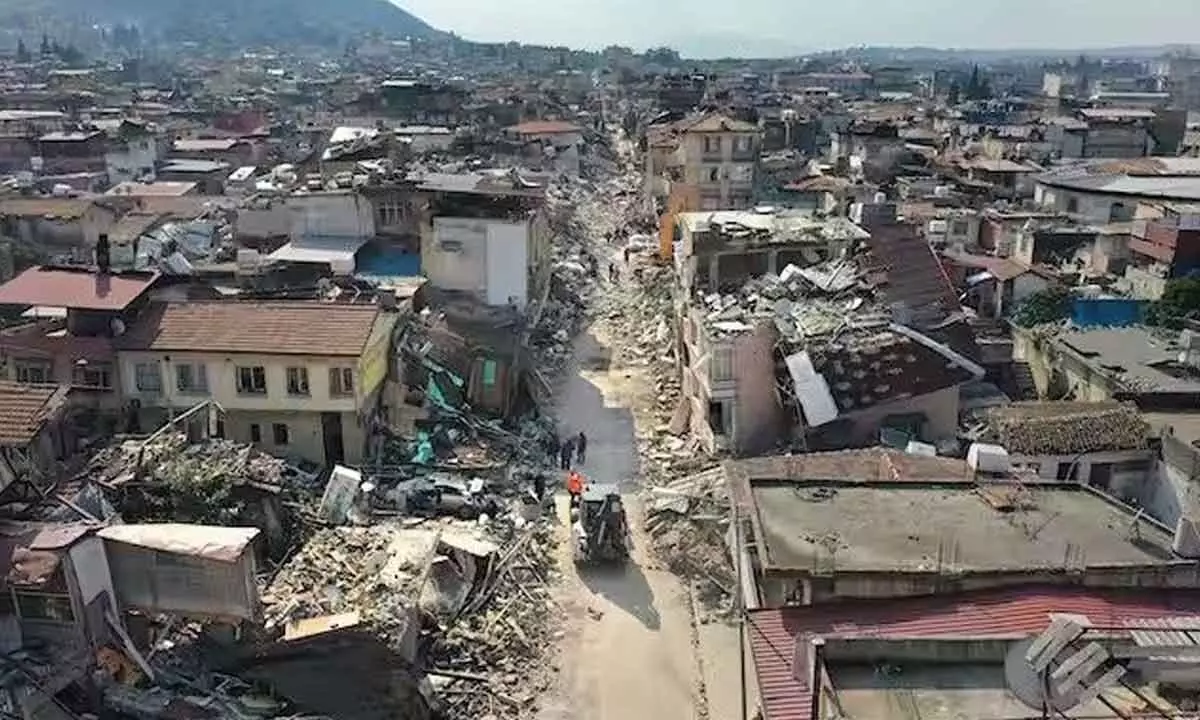Live
- Iraqi PM, Putin discuss regional situation, energy cooperation over phone
- Pushpa 2 Shooting Still Pending? Will It Release on Time?
- Can air pollution affect weight gain and hormonal health?
- Vishvaraj Singh Mewar's coronation ceremony in Chittorgarh on Nov 25
- KL Rahul’s Controversial Dismissal Sparks Debate in 1st Test at Perth
- Cricket Australia to honour late Philip Hughes on 10th anniversary
- Khushi Kapoor shines bright
- Suhana Khan’s power dressing game is inspiring
- Disha Patani sets the internet ablaze
- YSRCP Announces Boycott of PAC Elections
Just In
City that braved quakes, rose again


City that braved quakes, rose again
Turkiye’s historic city of Antakya, known in Roman and mediaeval times as Antioch, has been flattened by powerful earthquakes in the past – and rebuilt itself
Tens of thousands have died and millions have become homeless in southern Turkiye and northern Syria after the massive 7.8 earthquake that struck on February 6, 2023. But the ancient Turkish city of Antakya, known in Roman and mediaeval times as Antioch, has been here before.
In the late fourth-century Roman world, two days after a powerful earthquake shook the border of Turkiye and Syria, the Christian preacher John Chrysostom delivered a sermon to the frightened congregation in his shaken city of Antioch, much as survivors today struggle to understand the destruction. "Your nights are sleepless," he acknowledged, and possessions "were torn asunder more easily than a spider's web. … For a short time you became angels instead of humans." As a historian of Christianity in the late Roman world, my research on the Christianisation of Antioch took me to the area in 2006, 2008 and 2010, and my heart has been breaking to see the region where people welcomed me so generously shattered anew. It helps, though, to know Antakya's rich history and the resilience and courage of its people, who have rebuilt the city before.
Layers of time
The city has known numerous rulers in its long history, and notable religious diversity. Jewish, Christian and Muslim communities have called Antioch home since late antiquity to today. In the New Testament, Antioch is where Jesus's followers were first called "Christians," and the apostles Peter and Paul met in the city. Roman emperors often spent the winters in the temperate metropolis. The fourth-century Greek teacher Libanius declared in his oration "On Antioch" that this city on the Orontes River was so beautiful that even the gods preferred to dwell there.
The ancient Greek and Roman city came under Muslim control in 637, returned to Greek Christian control in the 10th century, Muslim control briefly in the 11th century, and then western Christian control in 1098 during the First Crusade. The Crusaders established the Principality of Antioch, which lasted until the 13th-century arrival of the Mongols, when after some struggles the city ultimately found itself ruled by the Muslim Mamluks based in Egypt. It became part of the Ottoman Empire in the 16th century, and after World War I, France oversaw the region as part of Syria until it was annexed by Turkiye in 1939.
It has received countless refugees since Syria's civil war started in 2011. During my visits, the textured layers of the city's long history were visible everywhere. The main Kurtulus Street followed the old Roman road, and the Habibi Neccar mosque, destroyed in the recent earthquake, commemorated the city's early Muslim history on a site that was previously a church. The Orontes River still flowed through the city, and modern homes nestled, as Roman homes once did, against the mountain where early Christian ascetics withdrew to pray; remnants of the Roman aqueduct and mediaeval stone walls snaked through the city and up the mountainside.
Trembling Earth
In his "Roman History" from the early third century, the early historian Cassius Dio described the catastrophic devastation and loss of life from the severe earthquake that ravaged the city in 115, as "the whole earth was upheaved and buildings leaped into the air." The early Christian historian John Malalas survived another devastating earthquake in the city in 526, and he described in his "Chronicle" the terrible fire that compounded the unfathomable destruction after "the surface of the earth boiled up and … everything fell to the ground."
Today as well, countless buildings have been flattened, like the historic Habibi Neccar mosque, which had already been rebuilt after another earthquake destroyed it in 1853. The mediaeval Crusaders built a towering stone entrance to the mountain cave church associated with the apostle Peter, and we wait to learn if it has been damaged. Malalas wrote that in 526, "Pregnant women … gave birth under the earth and came out with their infants unharmed," echoing the survival of a baby girl who was born in Antakya on Feb. 6, 2023, under the collapsed rubble of her home, and has been named Aya, an Arabic word that loosely translates as a sign from God.
The city's Hatay Archaeology Museum houses a breathtaking collection of Roman floor mosaics from its suburb Daphne, famous since Roman times for its natural springs, and the Ministry of Culture has personnel on-site to protect it. As neighbours dig through toppled buildings for survivors, the world rushes to bring aid. The scope of the catastrophe is heartbreaking, but these echoes from the Roman past can, I believe, provide a hopeful reminder of the resilience of the city's people who have rebuilt from devastating earthquakes before. Perhaps with the world's support, they can do so again.
(Writer works at University of Tennessee, US; The Conversation)

© 2024 Hyderabad Media House Limited/The Hans India. All rights reserved. Powered by hocalwire.com






